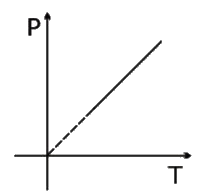If ideal diatomic gas follows the process, as shown in graph, where T is temperature in kelvin and V is volume (m3), then molar heat capacity for this process will be [in terms of gas constant R]:
![If ideal diatomic gas follows the process, as shown in graph, where T is temperature in kelvin and V is volume (m^(3)), then molar heat capacity for this process will be [in terms of gas constant R]:](https://d10lpgp6xz60nq.cloudfront.net/physics_images/RES_HAT_PHY_XI_C01_E01_183_Q01.png)
7R2
5R
19R6
11R2
The correct Answer is:C
C=Cv+R1−η……..(i)
T2V−3= constant ,PV=nRT
P2V2V−3= constat ,P2V−1= constant
PV−1/2= constant
N=−1/2
C=5R2+2R3=19R6
Topper's Solved these Questions
- KTG & THERMODYNAMICSBOOK - RESONANCECHAPTER - KTG & THERMODYNAMICSEXERCISE - PART -III
25 Videos
- KTG & THERMODYNAMICSBOOK - RESONANCECHAPTER - KTG & THERMODYNAMICSEXERCISE - PART -IV
10 Videos
- KTG & THERMODYNAMICSBOOK - RESONANCECHAPTER - KTG & THERMODYNAMICSEXERCISE - Exercise-2
1 Videos
- KINETIC THEORY OF GASES AND THERMODYNAMICSBOOK - RESONANCECHAPTER - KINETIC THEORY OF GASES AND THERMODYNAMICSEXERCISE - Exercise
64 Videos
- MAGNETIC FIELD AND FORCESBOOK - RESONANCECHAPTER - MAGNETIC FIELD AND FORCESEXERCISE - Exercise
65 Videos
Similar Questions
An ideal diatomic gas undergoes a process in which the pressure is proportional to the volume. Calculate the molar specific heat capacity of the gas for the process.
View SolutionAn ideal gas undergoes a process in which its pressure and volume are related as PVn=constant,where n is a constant.The molar heat capacity for the gas in this process will be zero if
View Solution
Knowledge Check
The molar heat capacity of a gas in a process
Ais either CVorCPBlies between CVorCPCmay range from zero to infinityDcan have any real valueThe pressure P of an ideal diatomic gas varies with its absolute temperature T as shown in figure. The molar heat capacity of gas during this process is [R is gas constant]
 A1.7 RB3.25 RC2.5 RD4.2 R
A1.7 RB3.25 RC2.5 RD4.2 ROne mole of diatomic ideal gas undergoing a process in which absolute temperature is directely proportional to cube of volume, then, heat capacity of process is :
A103RB116RC176RD3R
Find the value of molar heat capacity for an ideal gas in an adiabatic process.
View SolutionP - V diagram of a diatomic gas is a straight line parallel to P-axis. The molar heat capacity of the gas in the process will be
View SolutionP-V diagram of a diatomic gas is a straight line passing through origin. The molar heat capacity of the gas in the process will be
View SolutionAn ideal gas with adiabatic exponent γ=43 undergoes a process in which internal energy is related to volume as U=V2 . Then molar heat capacity of the gas for the process is :
View SolutionFor a certain process pressure of diatomic gas varies according to the relation P=aV2n, where a is constant. What is the molar heat capacity of the gas for this process?
View Solution
